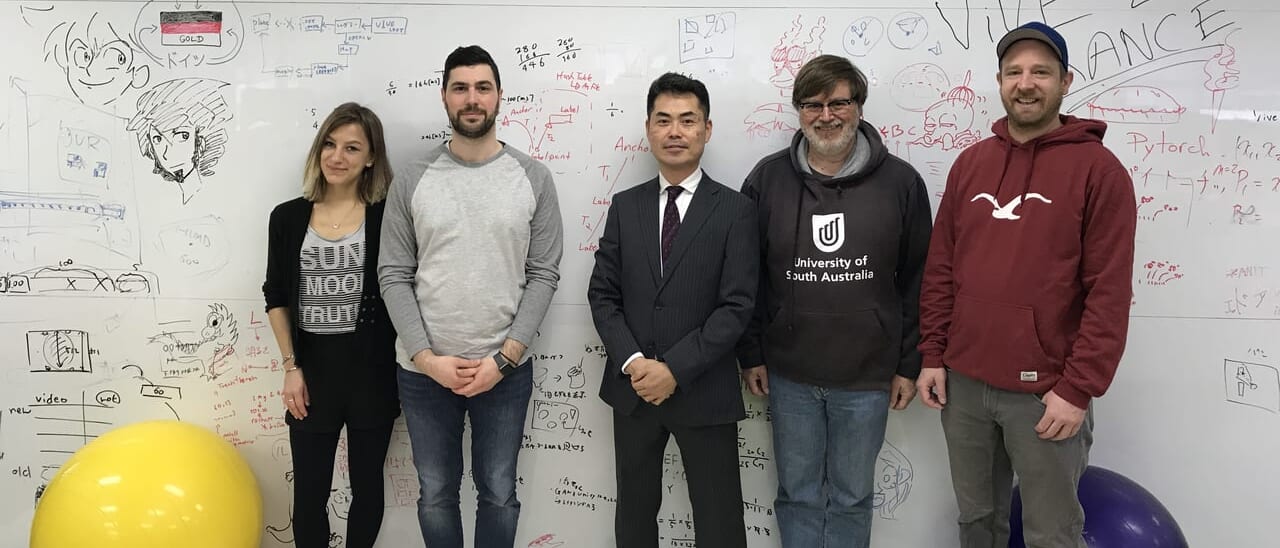~AR, VR and Beyond~
We are interested in human beings, and study on research for augmenting human capabilities and enrich our lives. From this perspective, we mainly conduct studies on sensing, display, and interaction technologies. Please refer to this page for more details about our research philosophy.
In reality, there are many complex research themes that span these three fields. Our research projects can be categorized into display hardware, human augmentation, multi-modal (multi-sensory) interfaces, cognitive and psychological aspects, visualization and media processing.
Display Hardware
Research projects on unprecedented display hardware for AR and VR. For example, we are developing head-mounted displays (HMDs) with a wide field of view comparable to that of the human eye, optical see-through HMDs that enable highly realistic expressions such as casting shadows on the real environment, and HMDs that flexibly present images only in the required field of view by combining smartphones and other devices.
* We have many more projects in this category.
Augmented Human
Research projects on human augmentation to make something possible that were impossible. For example, we are developing a system that supports work in a large environment as if you were a giant, a system that allows you to walk around with a third-person view of yourself like in a video game, goggles that modulate your vision to improve concentration, a system that allows you to shop alone even if you are blind, goggles that predict and visualize the future, goggles that zoom automatically when you look closely at them, and more.
* We have many more projects in this category.
Multi-modal Interfaces
Research projects on presenting multi-modal sensations other than vision and auditory such as the sense of taste and the sense of touch and force. For example, we are developing a system that enhances the rubber band illusion through electrical stimulation, a device that presents the force of a shot in the air for a virtual ball game, a device that can tickle yourself by devising visual and tactile presentation methods, a system that makes you feel as if you are floating or flying in the air, a device that makes you feel as if you are exercising more than you actually are, a system that modulates the appearance of food to manipulate the sense of taste, a device that make you feel the weight, texture, and responsiveness of virtual objects in the air, a device that makes you feel the weight, texture, and responsiveness of virtual objects in the air, a device that makes you feel full and sultry, and a device that makes you feel as if you are walking while sitting down.
* We have many more projects in this category.
User Interfaces
Research projects on user interfaces that exploit advanced media technologies. For example, we are conducting research on touch interfaces that transparently display and operate distant IoT devices in the palm of the hand, VR interfaces that allow web browser elements to be assembled like building blocks to create page summaries, and AR pets that are equipped with emotion models and recognize their surrounding environment. Example projects below include those developed by a short-term internship students.
* We have many more projects in this category.
Cognitive and Psychological Aspects
Research projects on cognitive and psychological aspects induced by various stimuli. For example, we are studying on research to investigate whether it is possible to make people perceive low gravity by tilting their bodies, research to investigate whether home appliances behave like living creatures to reduce the discomfort of maintaining them, research to investigate how simple movements that change the undulations of curved surfaces make people perceive living creature-like qualities, research to investigate whether modulating facial expressions and gestures can facilitate communication, research on how information presented in smart glasses affects subsequent work performance, research on guiding the user’s gaze without causing discomfort, research on visual effects to encourage behavior that approaches one’s ideal self, research on the effects of visuals at the beginning of the experience to make the VR experience more believable, and research to investigate the ease of noticing and seeing annotations in AR, and so on.
* We have many more projects in this category.
Visualization and Media Processing
Research projects on new ways of visualization and processing media. In particular, many of them are oriented toward applications in AR and VR. For example, we are conducting research on improving the quality of diminished reality, which removes unwanted real objects from view, research on AR simulations of earthquakes and fires that are more realistic by recognizing the surrounding environment, research on understanding video images by mapping images to language features using deep learning, research on recognizing dotted characters on printed material, research on rendering reconstructed 3D models at high speed using GPUs, and research on outdoor AR systems with no registration error at all.
* We have many more projects in this category.
Sensing
Research projects on sensing humans and the environment. Sensing targets are diverse and include human location, behavior, physiological state, environmental geometry, light source, and many others. For example, we are researching a method to precisely estimate the position and posture of an underwater object using only an IMU. In addition to the research that focuses solely on sensing listed below, sensing is widely used in many of the other research projects in other categories.
* We have many more projects in this category.
